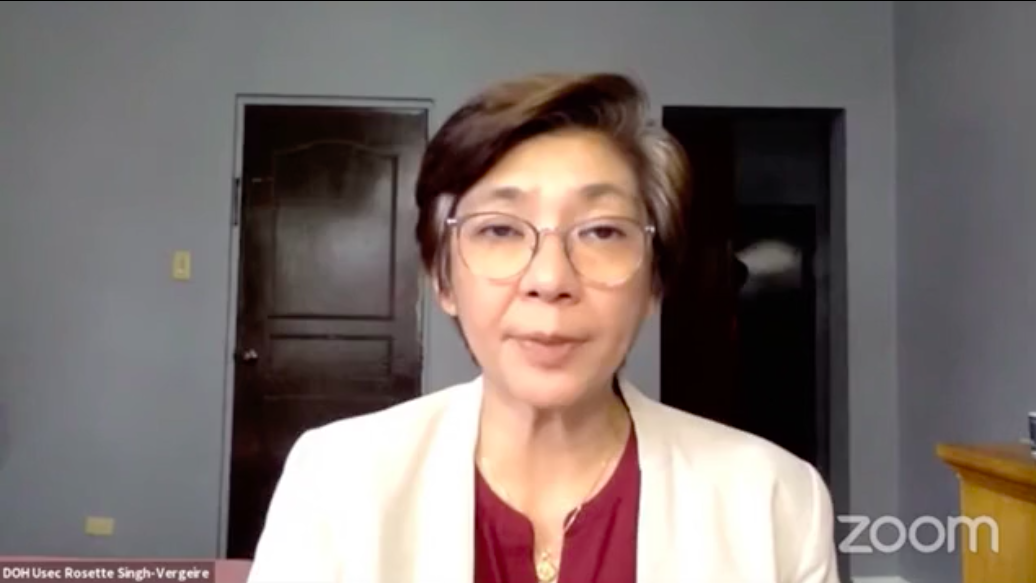DOH: Consider alert level 1 as ‘new normal’

Health Undersecretary Maria Rosario Vergeire. Screengrab from DOH Facebook page
While it cannot yet declare that COVID-19 has become endemic in the country, the Department of Health (DOH) said the government is preparing for what it called a shift to the “new normal.”
“We are preparing for this so-called new normal. Let us remember that alert level 1 is the new normal in the country,” Health Undersecretary Maria Rosario Vergeire said at a briefing on Friday.
Restrictions will be very specific and limited to areas with high risk of infection, while capacity limits in business establishments, whether indoor or outdoor, and in public transportation will be removed, she added.
The health official emphasized that “what would be retained would be our self-regulation. We still follow the minimum public health standard, we still do masking, we still do handwashing, avoid crowded areas, observe physical distancing, and most importantly, of course, ventilation, airflow.”
Vergeire said face masks would still be required, stressing that the policy on wearing of masks would be the last to be lifted. “If we will have a transition and easing of restrictions, I think the mask mandate will be the last to go because it will protect each and everyone of us—not just [from] COVID-19 but [from] the other respiratory infections also,” she added.
Dr. Edsel Salvana of the DOH Technical Advisory Group said the rule on wearing face masks could be eased gradually.
“Maybe outdoors first before … indoors, and the vulnerable population may possibly hang on to their masks a little longer. And for instance, during long trips in airlines,” he said.
Virus case update
The World Health Organization (WHO), he said, would be the one to announce whether the COVID-19 pandemic in the country is now in an endemic state. (See related story on Page A4.)The country continued to see a steady decline in new cases, with the DOH reporting 3,788 infections on Friday—lower than Thursday’s 4,575.
This was the fourth straight day that the tally fell below 5,000. The national caseload was now 3,630,637.
There were 91,147 active cases in the latest bulletin, of which 83,145 were mild, 3,261 were asymptomatic, 2,986 were moderate, 1,443 were severe and 312 were critical.
The 5,652 additional recoveries brought the total number of survivors to 3,484,636.
Seventy-two more fatalities raised the death toll to 54,854, with 32 deaths occurring this month, and the rest between June 2021 and January 2022 but only reported on Friday.
The positivity rate, or the percentage of tests that came out positive for COVID-19, was 14.7 percent—lower than the 15.1 percent on Thursday. This was based on 32,795 who were tested on Wednesday.
The WHO’s benchmark positivity rate of below 5 percent, sustained for two weeks, indicates that virus transmission is under control.
Intensive care beds in the National Capital Region (NCR) were now 24-percent full (against 34 percent at the national level), isolation beds at 29 percent (33 percent nationwide), and ward beds at 28 percent (30 percent at the national level).
The DOH said 17 percent of ventilators available for COVID-19 patients in Metro Manila were in use, against 19 percent for the whole country.
NCR topped the regions with the most number of cases with 470, followed by Western Visayas with 455, and Davao Region with 453.
For independent pandemic monitor OCTA Research, the capital region may already be classified as very low risk by March.
“The projections show a decrease to less than 200 new cases per day by end of February. The magic number to achieve very low risk classification is 140 new cases per day, which seems possible by March,” OCTA fellow Guido David said in a tweet.
gsg
For more news about the novel coronavirus click here.
What you need to know about Coronavirus.
For more information on COVID-19, call the DOH Hotline: (02) 86517800 local 1149/1150.
The Inquirer Foundation supports our healthcare frontliners and is still accepting cash donations to be deposited at Banco de Oro (BDO) current account #007960018860 or donate through PayMaya using this link.














